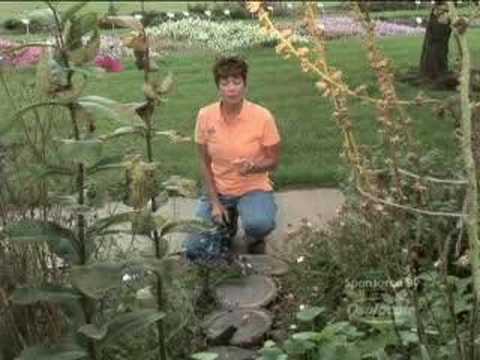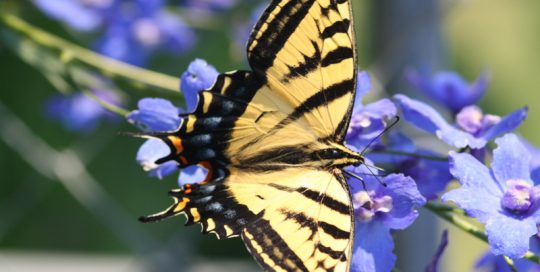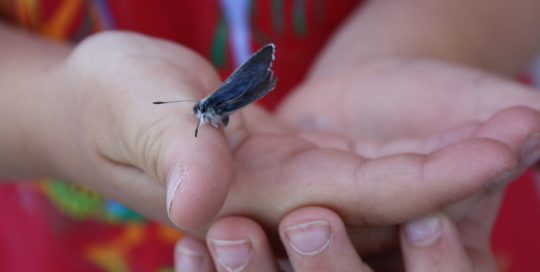Butterfly Eggs
Eggs are laid either singly, in rows, or in clusters. Once the eggs hatch, the caterpillars feed almost constantly. As they quickly grow larger, they shed their skins five or six times until the full-sized caterpillar crawls off to a sheltered spot where it sheds its skin one last time. The new skin hardens to become a chrysalis (also called a pupa). What happens next is positively magical. Inside the chrysalis, the caterpillar’s tissues are liquefied and rearranged—a process called metamorphosis—as it transforms into a butterfly.
I have found chrysalises hanging from the underside of chairs, on the side of the house and on branches. Last summer, a monarch caterpillar travelled more than 50 feet from milkweed plants, made it across the lawn, a sidewalk, onto the front stoop and up the side of a pedestal and ceramic container where it attached itself to the top of a small evergreen next to our front door. The pale green chrysalis was studded with gold dots like a piece of jewelry. Before long, we could see the dark wings forming inside, and within a matter of days the butterfly emerged and was gone.
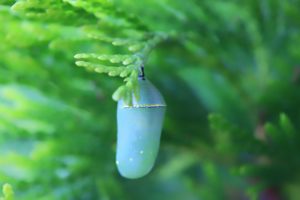
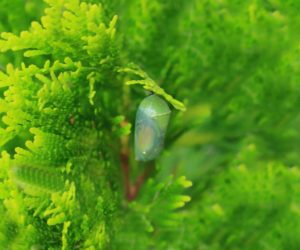
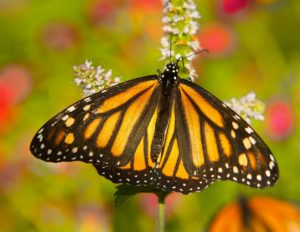
Top Photo: “Monarch Chrysalis”, Bottom Photo: (L) “Chrysalis – Wings Showing”, Bottom (R): “Monarch Caterpillar”. All Photos: Nina Koziol
The chrysalis stage may last a few weeks or as much as six months. When the adult butterfly is fully formed, the chrysalis skin splits and the butterfly emerges. It hangs on to the shed skin while its wings expand. The newly emerged adult slowly pumps liquid into its wings, which takes about an hour. If the wings aren’t fully extended in this time they may be deformed when they harden, preventing flight. If all goes well, the butterfly is soon ready to fly off in search of food and a new generation begins again.
Butterflies as Pollinators
All butterflies play an important role as pollinators and they are an essential element in the wildlife food chain. For example, some insects and birds feed upon butterflies and caterpillars. For that reason, I try to avoid using pesticides. These include “safer” insecticidal soaps or homemade concoctions because they can harm the eggs and caterpillars.
When I spot caterpillars on any of my plants, I check one of my bug books to identify them before I do anything. Often, I’ve found that the critters are the offspring of a butterfly or lady beetle and therefore beneficial. When I come across green loopers—moth caterpillars—eating my broccoli and cabbage plants, I pick them off and drop them into a pail of dishwashing suds.
Sacrificing a few leaves on my dill, carrots, fennel or parsley for hungry swallowtail caterpillars is well worth the joy I get watching them move about. Butterfly caterpillars seldom destroy ornamental plants. However, some like that of the giant swallowtail (aka orange dog), can damage citrus crops.
Many homeowners try to eliminate wild violets from their lawns and shade gardens. I like them because they are a host plant for the great-spangled fritillary. The butterfly mates in July and lays its eggs in August and September near the base of violets. Once the caterpillars hatch, they eat their eggshells and then hibernate all winter. In spring when the violets leaf out, the caterpillars begin eating them at night and hide under the plants during the day. This butterfly reproduces only once so I like to cultivate violets in my shade garden for them and for me.
After a summer rain, I sometimes spot butterflies standing in shallow puddles on my driveway. Occasionally I see them on the sidewalk, or on wet, bare soil, where they are “drinking” minerals rather than nectar. Others may visit animal droppings for their mineral diet. You can create a butterfly feeding station by filling a shallow saucer with moist sand and pebbles and placing it on the ground below your flowers.




